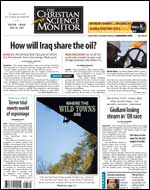from the May 10, 2007 edition
Is that painting real? Ask a mathematician.
Engineers use a mathematical process dubbed 'stylometry' to set apart real Van Gogh paintings from forgeries.
Page 2 of 2
Page 1 | 2
While the specifics of stylometric analysis differ depending on the medium being examined, the basic strategy is similar across the board. First, the work of art in question is divided into components, which can be words, high and low tones, or different visual frequencies (the frequency of a still pond in a painting is distinct from that of a busy flower garden, for example). Next, each component is subjected to statistical tests that measure how they compare to components of authentic works created by the same artist. Mathematicians can plot the point that represents how the work performs on these tests in n-dimensional space, with n being the number of tests used. In his attempts to differentiate genuine Brueghel sketches from fakes, for instance, Mr. Rockmore measured 72 statistical features of each disputed sketch, such as the percentage of light and dark portions in a given visual frequency.
"We took the entire body of known Brueghels and said, 'Do we believe this picture's distance from the known Brueghels is significant?' " he says. The real Brueghels were statistically uniform, clustering on a geometric plot, while imitations ranged all over the map.
Statistician Jose Binongo of Emory University in Atlanta used a related strategy when he set out to determine who wrote "The Royal Book of Oz," published under L. Frank Baum's name in 1921. Many Oz fans insist the book is Baum's last hurrah, but others contend his collaborator, Ruth Plumly Thompson, wrote it.
To resolve the debate, Mr. Binongo split samples of known writings by Baum and Thompson into 5,000-word segments, then isolated the 50 most commonly used words in each segment. Counting how frequently each of these 50 words was used yielded a sequence of 50 numbers that specified a point in 50-dimensional space. Baum's and Thompson's excerpts occupied distinctly different zones in this space. And when Binongo performed the same analysis on chunks from "The Royal Book of Oz," the points generated all clustered in Thompson's zone, persuading many historians that she is the true author.
Even as historians and academics acknowledge stylometry's validity, they sometimes express an almost visceral aversion to it. "Is it true that every artist has one clearly identifiable, characteristic style that can be picked up by this technology?" wonders Ellen Handy, an art historian at the City College of New York. "Can artists really be resolved to a single pattern?"
1 | Page 2






